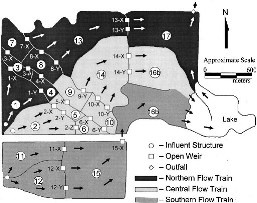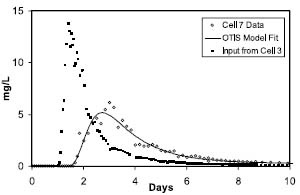|
|





Christopher J. Martinez, Ph.D
Efficacy and Transient Storage of Municipal Treatment Wetlands.
This project was conducted to evaluate the impact of pollutant residence times and flow patterns through the Orlando Easterly Wetland on nutrient removal
This project was conducted to evaluate the impact of pollutant residence times and flow patterns through the Orlando Easterly Wetland on nutrient removal
Christopher J. Martinez, Ph.D
279 Frazier Rogers Hall
PO Box 110570, University of Florida
Gainesville, FL 32611
279 Frazier Rogers Hall
PO Box 110570, University of Florida
Gainesville, FL 32611
Phone: (352) 392-1864 x279
Fax: (352) 392-4092
Email: chrisjm@ufl.edu
Fax: (352) 392-4092
Email: chrisjm@ufl.edu
efficacy. This project was conducted to
evaluate the impact of residence times and
flow patterns through the Orlando Easterly
Wetland on nutrient removal efficacy.
Residence time distribution analysis of bromide tracer tests revealed and quantified inefficiencies (short circuiting and dead zones) in the hydraulic performance within individual treatment cells and the wetland system under the operating conditions studied.
Residence time distribution analysis of bromide tracer tests revealed and quantified inefficiencies (short circuiting and dead zones) in the hydraulic performance within individual treatment cells and the wetland system under the operating conditions studied.
The model one-dimensional transport with inflow and storage (OTIS)
was then calibrated to results from the bromide tracer to quantify
short-circuiting of the treatment volume and temporary storage of
tracer in isolated, low-flow regions. The OTIS model results indicated
the presence of three distinct hydraulic ‘zones’ of the wetland. The
first, an actively flowing main channel; the second, a temporary
storage zone where water and constituents are exchanged with the
main flow channel; and the third, completely isolated, ‘dead’ water.









